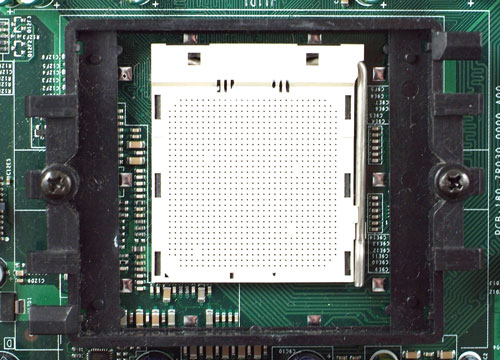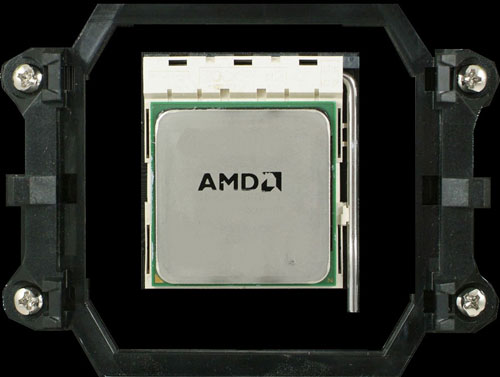AMD AM2: More than just a Memory Change
by Wesley Fink on February 6, 2006 1:30 AM EST- Posted in
- CPUs
New AM2 Cage
With the two 940 sockets so similar you would reasonably expect existing heatsink/fans to work on the new AM2.
It appears AM2 will change this ongoing HSF compatibility with a brand new, and mostly incompatible, heatsink cage design. The new AM2 design, if it makes it to final production, is a nice upgrade to the existing Athlon 64 HSF mounting design, but there are almost no current Athlon 64 HSFs that will fit the new design.
If you look at the designs side-by-side you can see the differences more clearly.
Socket 939/940/754 HSF Cage

AM2 HSF Cage
In addition the current high-end designs, which replace the existing cage with a new mounting system just simply won't work. The current Athlon 64 design uses one screw on each side in the center of the mounting lug. The new AM2 design uses four corner mounted screws - more secure but not useful for mounting current 2 screw mounting schemes.
Current Athlon 64 heatsinks that use a single lug for mounting and no cam for locking will likely work on the new AM2 cage. Recently shipped AMD retail heatsinks have a single lug connection and a lever lock without the locking cam. Those should work fine on the new AM2. However, not a single third party HSF in our lab - the kinds our readers most likley use - would mount properly on the new AM2 cage.










50 Comments
View All Comments
PrinceGaz - Monday, February 6, 2006 - link
You'll be fine, the existing XP-90[C] and XP-120 come with an adapter for S478, and another for S754/939/940. To use the heatsinks with LGA775, you have to buy a LGA775 adapter that ThermalRight sell seperately for US$5. I would wager that Thermalright will simply produce an AM2 adapter for the heatsinks in due course, so for around US$5 you'll be able to use your XP-120 with an AM2 socket.MadAd - Monday, February 6, 2006 - link
Same here, I'm using an Si-120.... hopefully there will be conversion frame available for a small price- anythings better than having to fork out for a new one as I cannot see M2 CPUs having a hugely greater thermal density to outpace the Si.hans007 - Monday, February 6, 2006 - link
i think the whole northbridge so we can use different ram types idea is why intel sticks witha northbridge.i mean, i do find it rather limiting when i work with an AMD based system, that say i HAVE to use registered dimms on opterons, have to use only normal dimms on normal Athlon 64s etc, when on an intel setup you can just buy the motherboard that fits your memory (and motherboards are cheaper than memory in most cases)
Intel may never go to an onboard controller and may just try to reduce latency on their current ones (nvidia has proven they can reduce it more than intel).
The fact that the socket is so similar and is also 940 pins no doubt will lead to people putting the wrong chip in the socket, ordering the wrong type etc.
I dont understand why they didnt just add like 10 random pins. say make it socket 945. at least people would not order the wrong item, etc or even come close to confusing it. And why the hsf change? granted its mounted with 4 screws instead of 2 (i.e. like intels) but what is the point. they probably only have that for heavier heatsinks (perhaps they actually need heavier hsfs who knows).
Anyhow, I doubt this refresh is going to make any difference performance wise, if anything it reduces computer manufacturing costs, since DDR2 is already cheaper than DDR and the gap will continue to widen.
mesyn191 - Monday, February 6, 2006 - link
i mean, i do find it rather limiting when i work with an AMD based system, that say i HAVE to use registered dimms on opterons, have to use only normal dimms on normal Athlon 64s etc, when on an intel setup you can just buy the motherboard that fits your memory (and motherboards are cheaper than memory in most cases)Opterons are for server use only, and in a server registered DIMMs are pretty much a standard requirement so I have no idea in the world why you would complain about that... Or why you'd complain about not being able to use em' on a regular A64, they're slower and more expensive than regular DDR DIMMs and consumer grade hardware (like a A64) doesn't need the added RAS support that registered DIMMs can provide.
Intel may never go to an onboard controller and may just try to reduce latency on their current ones (nvidia has proven they can reduce it more than intel).
An ODMC will always be significantly faster than a northbridge, ecspecially for DDR2 which has significantly higher latency than DDR.
I dont understand why they didnt just add like 10 random pins. say make it socket 945. at least people would not order the wrong item, etc or even come close to confusing it. And why the hsf change? granted its mounted with 4 screws instead of 2 (i.e. like intels) but what is the point. they probably only have that for heavier heatsinks (perhaps they actually need heavier hsfs who knows).
More pins cost more money, the amount they already have on the package is amazing for a mass produced product, probably eats up a large portion of thier per chip profits. There is a reason why Intel went with a pinless package you know, and it wasn't just because of bus singaling issues... 4 hole HSF mounting distributes the pressure more evenly over the motherboard surface, prevents the PCB from flexing when mounting a HSF.
Anyhow, I doubt this refresh is going to make any difference performance wise, if anything it reduces computer manufacturing costs, since DDR2 is already cheaper than DDR and the gap will continue to widen.
If you're expecting 20%+ performance gains then yea, you WILL be dissappointed, but 10% or so is not out of question with a new ODMC + DDR2.
PrinceGaz - Monday, February 6, 2006 - link
I suppose they could have added an extra pin and called it Socket 941, but there shouldn't be any confusion anyway as it is called "Socket AM2", not "New Socket 940". The only people that could spread potential confusion are those that insist on referring to it as a new socket 940, rather than correctly calling it socket AM2.Ropey - Monday, February 6, 2006 - link
So in order to utilize ddr2 there is an entirely new formfactor? AMD is a bit too quick to change sockets imo.This just makes no sense to me.
R
avbauwel - Monday, February 6, 2006 - link
So you'd rather have the same socket with completely different singnal traces?That'd enable you to A: possibly blow up your CPU if you insert the wrong CPU in the socket (memory voltage is different for DDR/DDR2, traces are different) B: buy a new motherboard and then notice you cannot use your current CPU and memory.. But still it has the same socket.
i rather have a new socket when memory changes, then keeping the same socket.. Makes it alot easier to find the correct motherboard for the new CPU's, especially for the non-enthousiasts out there buying PC's..
Btw: if you think AMD is changing quickly (s939 is NOT dead yet btw ;)), take a look at inbtels track record for needed mainboard changes with CPU versions changing, and then i'm not even talking about a memory controller change...
breethon - Monday, February 6, 2006 - link
I just sunk over $700 into a rig with a new Venice core 939 cpu, right before the 940 revolution started(like a month)....oh well. The main reason I switched from Intel (had Intel since my Pentium 150 classic)was the fact that every upgrade i needed to buy a new stinking motherboard. I was totally impressed with the way that AMD stuck to their socket design for soooooo long......DOH!WhoBeDaPlaya - Wednesday, February 8, 2006 - link
Tell me about it. Socket A is still kinda alive for crying out loud.Long live Socket 754! :P
DigitalFreak - Monday, February 6, 2006 - link
I think Intel sticks to the same socket for as long as AMD does, but they change their VRM requirements a lot.